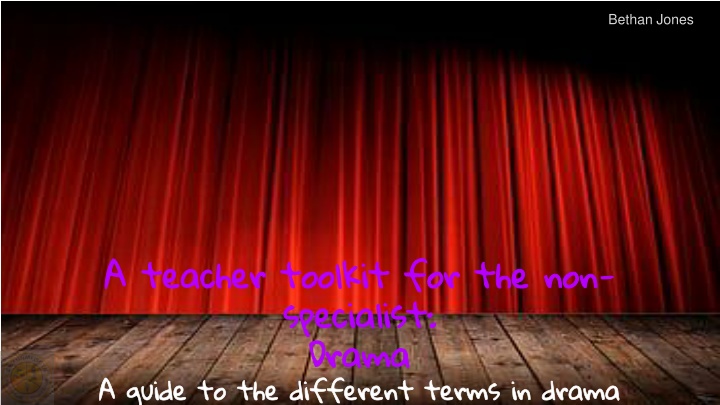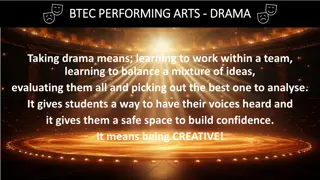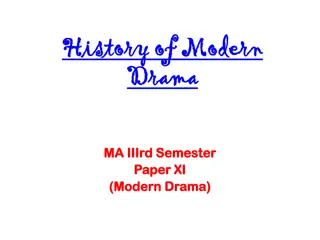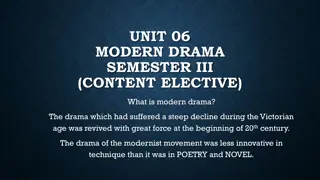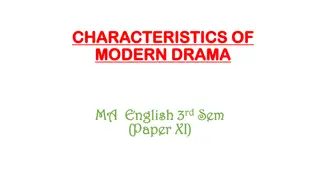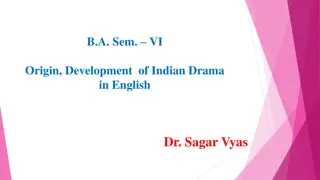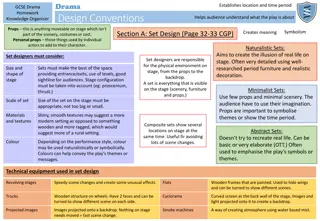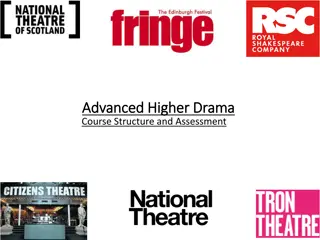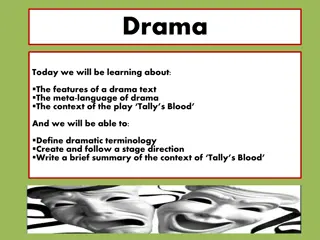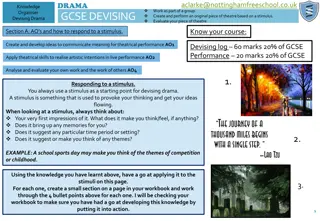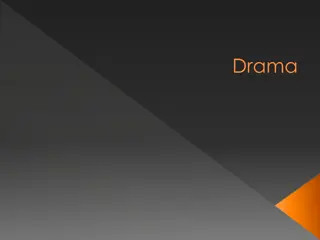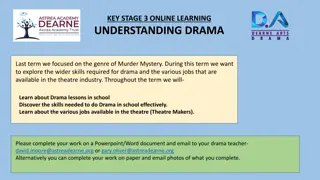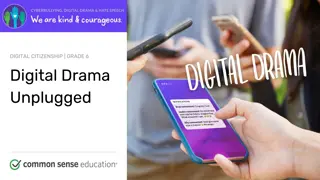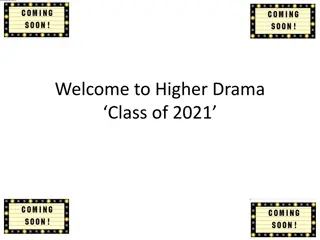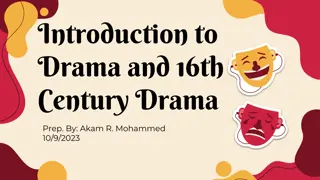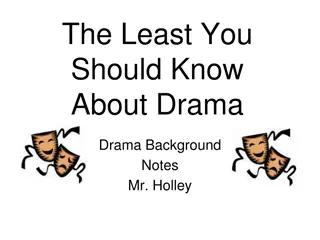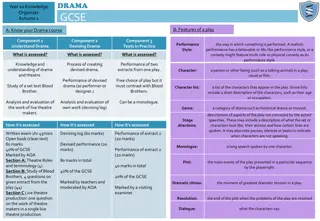A Comprehensive Guide to Drama Teaching for Non-Specialists
Bethan Jones explores the essence of drama, its benefits, and how it enriches children's lives. The guide delves into key drama terminology, emphasizing improvisation, scripts, props, scenes, and more. With a focus on creative expression and active learning, this toolkit empowers educators to engage students through the art of drama.
Download Presentation

Please find below an Image/Link to download the presentation.
The content on the website is provided AS IS for your information and personal use only. It may not be sold, licensed, or shared on other websites without obtaining consent from the author.If you encounter any issues during the download, it is possible that the publisher has removed the file from their server.
You are allowed to download the files provided on this website for personal or commercial use, subject to the condition that they are used lawfully. All files are the property of their respective owners.
The content on the website is provided AS IS for your information and personal use only. It may not be sold, licensed, or shared on other websites without obtaining consent from the author.
E N D
Presentation Transcript
Bethan Jones A teacher toolkit for the non specialist: Drama A guide to the different terms in drama A teacher toolkit for the non- - specialist: Drama A guide to the different terms in drama
Bethan Jones What is drama? What is drama? A drama is a type of story acted out before an audience, often in a theatre. The word drama comes from a Greek word meaning action . Most dramas focus more on the relationships between people than on the actions
Why teach drama? Why teach drama? Bethan Jones Dramatic activity is already a natural part of most children s lives in the form of make-believe play, enabling them to make sense of their own identity by exploring meaningful fictional situations that have parallels in the real world. This can be utilised through structured play and drama to encourage pupils to learn actively and interactively across the curriculum. Rather than sitting still and listening they are encouraged to move, speak and respond to one another. Students who are challenged by reading and writing often respond more positively to the imaginative and multi-sensory learning offered by drama. This in turn helps them develop such skills as creativity, enquiry, communication, empathy, self confidence, cooperation, leadership and negotiation. Most importantly, drama activities are fun making learning both enjoyable and memorable.
Bethan Jones What are the benefits of teaching drama? What are the benefits of teaching drama? Drama gives children opportunities to explore, discuss and deal with difficult issues and express their emotions in a supportive environment. It enables them to explore their own cultural values and those of others, past and present. It encourages them to think and act creatively, thus developing critical thinking and problem-solving skills that can be applied in all areas of learning. Through drama, children are encouraged to take responsible roles and make choices to participate in and guide their own learning. Teachers can take a more open-ended approach, concentrating on the process of learning at least as much as if not more than the product.
General drama terminology/ vocabulary Improvisation Working as a team or individually to explore ideas practically and create a performance Script A piece of writing for the stage. It contains a list of characters, dialogue and descriptions of the action taking place. Usually made up of acts and scenes General drama terminology/ vocabulary Improvisation Bethan Jones Props Objects that are held and used by an actor on stage to make a performance more realistic Props Script Scenery/ backdrop The scenery/backdrop is behind the actors and shows you where the action is taking place. Scenery/ backdrop Plot The sequence of events that make up the story Plot Scene A section of a play. A group of scenes make up an act. Scene Mime Acting without words through movement alone Mime Act A section of a play made up of scenes. A play usually has several acts. Act
Bethan Jones General drama terminology/ vocabulary Characterisation Creating a character, changing your voice and movement to play a particular role General drama terminology/ vocabulary Characterisation Dramatic irony When the audience knows what is happening but the actors on stage do not know what is happening Genre The different styles of performances Dramatic irony Devising Creating a piece of drama from a starting point/stimulus Devising Genre Ad lib Actors ad lib when not speaking the words of the script, usually for comic effect or to hide an unexpected pause Ad lib Blocking Working out where actors will stand and move to/from Blocking
Bethan Jones Dramatic techniques Ways to convey the character s intentions or emotions Dramatic techniques Ways to convey the character s intentions or emotions
Bethan Jones Pitch The highness/lowness of a sound Pitch Voice Volume How loudly/softly words are spoken Voice Volume Pace The rate at which the words are spoken Pace Breathing Breathing To allow controlled use of the voice, to convey a feeling e.g. a sigh or a gasp Projection This enables the audience to hear the voice Projection Emphasis Choosing to stress particular words to convey meaning Emphasis Articulation The clarity of the voice Articulation Tone The feeling/emotion in the voice Tone Pause Pause Where sound stops, how often and for how long, this can add tension Cueing When to speak Cueing
Bethan Jones Body Body Eye contact Establishing eye contact with another actor or the audience Eye contact Posture Stance, way of standing Posture Gesture Movement of any part of the body to express an idea, feeling or mood Gesture Facial expression Using the face to show mood, emotions, feelings and responses Facial expression Body awareness The ability to select appropriate use of the body on stage, choosing to use the whole body, or isolated parts of the body expressively Body awareness
Bethan Jones Movement Movement Repetition Repeating or recycling a movement for emphasis Repetition Timing Fast or slow tempo, when you move (kinaesthetic response), duration (length) of movement Timing Energy How you move, the amount of force, the mood expressed through movement Energy Direction Where you are going- forwards, backwards, diagonally, sideways Direction Pathways The pattern of movement that you create in a space, e.g. curved, straight, zigzagged Pathways Ensemble awareness Moving as part of a group, proximity to other actors, responding to others movements. Unified- moving as a whole group, complementary- moving in relation to others or the space, contrasting- moving in contrast to others or the space Ensemble awareness
Bethan Jones Use of space Use of space Levels Low, medium, high. Up high can show power/strength. Bent down low can show weakness. Levels Personal space Your own space, the bubble immediately around your body, how you use this space Personal space Architecture The physical structures of the space you are in, how you interact with these structures Architecture General space All other space in the room, how you use this space General space Proximity The amount of distance or space between actors, the amount of space between actors and the audience. Closeness portrays intimacy, distance can portray tension or dislike Proximity
Drama strategies These help to develop enquiry skills, to encourage negotiation, understanding and creativity Drama strategies These help to develop enquiry skills, to encourage negotiation, understanding and creativity Bethan Jones
Drama strategies Story telling Drama strategies Bethan Jones Storytelling is one of the simplest and perhaps most compelling forms of dramatic and imaginative activity. A good place to start is by telling stories to your pupils and encouraging them to share stories with one another. All of us can become engaging storytellers with a little practice. There may also be members of staff who are particularly skilled at telling stories, or you could invite a professional storyteller into the school. Listen to each other, watch videos of storytelling and encourage the children to identify techniques they could use in their own stories.
Drama strategies Role play Drama strategies Bethan Jones Role play is the basis of all dramatic activity. The ability to suspend disbelief by stepping into another character s shoes comes quite naturally to most children. Through the structure of the drama lesson this can be used to great effect, challenging children to develop a more sensitive understanding of a variety of viewpoints whilst sharpening their language and movement skills. By adopting a role, children can step into the past or future and travel to any location, dealing with issues on moral and intellectual levels..
Drama strategies Freeze frame Drama strategies Bethan Jones Freeze frames are a quick and effective way to start a drama session. They can easily be used with any age from children to adults. Participants create an image using their bodies with no movement. Freeze frames can be made by individuals, small groups or even the whole group. A good way to explain a freeze frame (also known as still image) is that it is like pressing the pause button on a remote control, taking a photo or making a statue. The images can be made quickly without discussion or they can be planned and rehearsed. They are very useful as an immediate way of communicating ideas or telling a story. They can be used to represent people or objects and even abstract concepts like emotions or atmospheres. As there are no lines to learn, freeze frames can help shyer performers to gain confidence
Drama strategies Thought tracking Drama strategies Bethan Jones Thought tracking is a natural follow-up to freeze frames. Once children have made a freeze frame, explain that when you tap them on the shoulder you would like them to speak the thoughts or feelings of their character aloud. This may just be one or two words but children will soon gain confidence to express themselves in longer sentences. It doesn t take long to thought-track each child in a group so that you reveal a wide range of attitudes and feelings from different characters. Students may want to be inanimate objects or animals in a freeze frame. This is fine, animal characters can have thoughts such as grrrr or I m hungry and you may find that even a lamppost can express its opinion, especially if you have used speaking objects with pupils. You can ask characters specific questions such as what they feel about another character, what they are dreaming or what they want to do next.
Drama strategies Tableaux Drama strategies Bethan Jones In a tableau, participants freeze frame their bodies to represent a scene. A tableau can be used to quickly establish a scene that involves a large number of characters. Because there is no movement, a tableau is easier to manage than a whole-group improvisation yet can easily lead into extended drama activities. It can be used to explore a particular moment in a story or drama, or to replicate a photograph or artwork for deeper analysis. Students stand in a circle, or around the performance area and a theme is given. One by one, they step into the space and establish freeze frames in relation to one another until the tableau is complete. At this point, thought tracking can be used to find out more about each of the characters. The scene can also be brought to life through improvisation, with the teacher clapping their hands to signal the beginning and end of the action. Once students are familiar with the technique, they can also work in small groups on different aspects of a theme.The class can discuss each group s tableau in turn, mentioning what they can see happening, what they would like to know more about and what they think could happen next. Afterwards, each group can comment on how these viewpoints compared with their initial intentions.
Drama strategies Action clip Drama strategies Bethan Jones Follows on well from freeze frame and thought tracking. Bring the frozen scene alive for a few moments with speech and movement. This could be initiated by giving the instruction Action . Allow the improvisation to run for a few moments (ideally before the performers run out of ideas) and then end it with another instruction such as Cut Action Clip gives the students the opportunity to enjoy acting out a small part of the story without worrying about how to start or finish the scene. The teacher can easily control how much is shown, especially if the students start to repeat themselves or run out of things to say. After a few sessions of working in this way students will become more confident about devising and presenting short scenes.
Drama strategies Flashbacks and flashforwards Drama strategies Bethan Jones Performers in a scene are asked to improvise scenes which take place seconds, minutes, days or years before or after a dramatic moment. This enables the exploration of characters backgrounds, motivations and the consequences of their actions. The method can be used to quickly bring depth to activities involving freeze frames or improvised drama. Adding Flashbacks or Flash Forwards creates a context it shows what led up to a particular moment, how it might be resolved or how it may lead onto additional challenges. The technique helps to flesh out a dramatic moment or create the beginnings of a story. With a group that has created a still image, explain that when you clap your hands, you would like them to move silently in slow-motion to where their character was a few moments before. When they are frozen still in the new image, you can use thought-tracking to explore character motivation. Now ask them to move back to their original image which is the present moment. Then you can use Flash Forwards participants move in slow-motion to indicate where their characters might be a short time after this moment. In this way you have created an episode with a beginning, middle and end and can develop it in any number of ways.
Drama strategies Conscience Alley Drama strategies Bethan Jones Also known as thought tunnel or decision alley. A useful technique for exploring any kind of dilemma faced by a character, providing an opportunity to analyse a decisive moment in greater detail. The class forms two lines facing each other. One person walks between the lines as each member of the group speaks their advice. It can be organised so that those on one side give opposing advice to those on the other. When the character reaches the end of the alley, they makes their decision.
Drama strategies Hot seating Drama strategies Bethan Jones A character is questioned by the group about his or her background, behaviour and motivation. The technique is additionally useful for developing questioning skills with the rest of the group. The traditional approach is for the pupil playing the character to sit on a chair in front of the group, although characters may be hot-seated in pairs or groups. It is helpful if the teacher takes on the role of facilitator to guide the questioning in constructive directions.To help students begin you can try hot-seating children in pairs (e.g. a pair of street urchins) or in groups (e.g. environmental protesters, refugees). If the background of the character is familiar to the pupils, then it may not be necessary for those playing the characters to do much preparation. Although some roles obviously require research you may be surprised at how much detail students can add from their own imaginations. It is important that the rest of the group are primed to ask pertinent questions. Don t get bogged down in facts during hot seating, but concentrate on personal feelings and observations instead.
Drama strategies Hot spotting Drama strategies Bethan Jones Start with a freeze-frame showing a scene. Use thought-tracking to hear the thoughts of the characters. Now choose one of the characters and ask the audience if they have any questions about what that character has said motives, thoughts and feelings. The character stays within the freeze frame while within the scene but can move while answering. This is similar to hot-seating but it can be a lot easier for the characters to answer as they are already in role within the scene.
Drama strategies Teacher in role Drama strategies Bethan Jones Teacher in role validates and supports the children s involvement in a make-believe situation by enabling the teacher to work and play alongside them. It is an instant way of setting a scene and directly involving the pupils. Children are used to stepping into and out of role in everyday play and are likely to be keen to participate. Teacher in Role does not require great acting skills. The strategy simply involves stepping into somebody else s shoes for a while to put forward their point of view. This can be done by subtly changing your tone of voice and body language to communicate key attitudes, emotions and viewpoints. A role can be adopted quite simply to communicate the key attitudes and emotions of a particular character. It won t take much for most children to believe in your character although the use of a token prop or piece of costume will clarify when you are stepping in and out of role: When I put on this scarf I will be Anne Frank , or When I sit in this chair I will be the King . If you are unsure how to begin, try hot-seating first. This will give you valuable experience of assuming a role in relation to the students and responding to their comments and questions. You can progress to teacher in role by encouraging the students to participate and becoming more active as the character. Reply to their questions as though they are also in role and encourage them to become involved in occupational mime activities.
Drama strategies Mantle of the expert Drama strategies Bethan Jones Mantle of the Expert involves the creation of a fictional world where students assume the roles of experts in a designated field. Mantle of the Expert is based on the premise that treating children as responsible experts increases their engagement and confidence. They can perceive a real purpose for learning and discovering together in an interactive and proactive way providing them with skills and knowledge they can apply to their everyday lives. It encourages creativity, improves teamwork, communication skills, critical thought and decision-making. A problem or task is established and the pupils become a team of experts using imaginative role-play to explore the issue. Usually an imaginary client such as a museum commissions the team.The children may be involved in mimed activities, improvisation, research or discussion. While the focus is on the enquiry process, it can often lead to real outcomes such as writing letters, printing leaflets or selling products. The teacher s role is to guide the drama, stepping in and out of role as necessary, providing encouragement and motivation to the experts.
Drama strategies Cross cutting or Split screen Drama strategies Bethan Jones Cross-cutting (also called split-screen) is a drama technique borrowed from the world of film editing, where two scenes are intercut to establish continuity. In drama and theatre the term is used to describe two or more scenes which are performed on stage at the same time. This makes it possible to juxtapose scenes or snippets of scenes that happen at different times or in different places, using separate areas of the performance space.The technique is used to highlight or contrast a particular theme or aspect of the story. Using different groupings, both scenes could happen at the same time, or one could be frozen while the other comes alive.This can have a similar effect to spotlighting particular areas of the stage or using a split- screen in a film. Why use it? Cross-cutting is invaluable for analysing themes in the performance of a drama by directly comparing or contrasting elements of the story.
Drama strategies Spotlight Drama strategies Bethan Jones Spotlighting is a useful teaching technique for sharing improvised drama when you have divided the class into smaller groups. When it is time to show their work, ask all the groups to sit on the floor. Explain that you will walk around the room and as you get closer to each group, that group will stand up and show their performance. As you move off towards the next group, they will stop the drama and quietly sit down again so that they can watch other groups. This is an effective way of controlling the time each group takes to show their work and overcomes the problem groups often have of not knowing how to end an improvisation. The teacher controls the time taken by each group and the order in which they perform. Just like a real spotlight, the technique focuses the attention on one part of the room at a time and makes it clear as to which group is taking its turn.
Drama strategies Marking the moment Drama strategies Bethan Jones Marking the Moment is a dramatic strategy used to highlight a key moment in a scene or improvisation. This can be done in a number of different ways: for example through slow-motion, a freeze-frame, narration, thought-tracking or music. It has a similar effect to using a spotlight to focus attention on one area of the stage at a particular moment during a performance.
Drama strategies Narration Drama strategies Bethan Jones Narration is a technique whereby one or more performers speak directly to the audience to tell a story, give information or comment on the action of the scene or the motivations of characters. Characters may narrate, or a performer who is not involved in the action can carry out the role of narrator .
Drama strategies Soundscapes Drama strategies Bethan Jones The group is conducted to create a sound picture or soundscape using their voices and bodies. The leader or one member of the group acts as conductor, whilst the rest of the group are the orchestra . Using their voices (and body percussion if appropriate), the group paints a sound picture of a particular theme, for example the seaside, a city, a jungle. The leader controls the shape of the piece by raising their hand to increase the volume or bringing it to touch the floor for silence. One way to do this is to allow everybody to choose their own sound discuss what types of sound might be appropriate before you start. Or, if it is a very large group, or very lively, you can divide the participants into sections, giving a particular sound for each section, then conduct them accordingly. The group should bear in mind contrasting and complementary sounds and try to be aware of natural peaks and troughs in the piece or the conductor can try to create these. Soundscapes can easily be used as part of an improvisation or performance
Drama strategies Role on the wall Drama strategies Bethan Jones In Role on the Wall, the outline of a body is drawn on a large sheet of paper, which is stuck onto the wall. This can be as simple as a drawing of a gingerbread man, or the teacher can carefully draw around one of the participants lying on a roll of paper. Alternatively you can project an image onto the paper and draw around the silhouette. Words or phrases describing the character are then written directly onto the drawing or stuck on with sticky notes. This drama technique can be carried out as a group activity or by individuals writing about their own character. You can include known facts such as physical appearance, age, gender, location and occupation, as well as subjective ideas such as likes/dislikes, friends/enemies, opinions, motivations, secrets and dreams.
